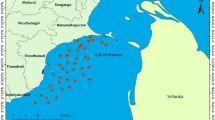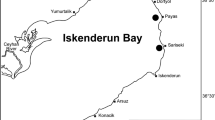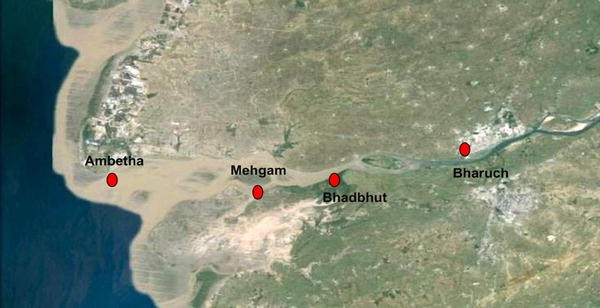Abstract
During the period (July 2014–June 2015) of investigation, 85 finfish species belonging to 65 genera, 35 families and 12 orders were encountered from 72 km stretch of Narmada estuarine region. The order Perciformes was found dominant (30 species) followed by Siluriformes (18 species), Cypriniformes (15 species), Clupeiformes (8) etc. Four species such as Tor tor, Wallago attu, Ompok bimaculatus and Ailia coila found under Near Threatened and Cyprinus carpio as a Vulnerable category during the investigation. During 2014–2015, the total fish production from Narmada estuary was 1618 tonnes and it exhibited a decline trend with species like Tenualosa ilisha, Tor tor, Labeo fimbriatus, Rita rita, Rita gogra and Notopterus notopterus being the most affected species. It could be attributed to various factors like the construction of dams, industrial effluents, domestic sewage, over fishing and habitat destruction. It needs suitable interventions for conservation of rich fish diversity of the estuary.
Similar content being viewed by others
Avoid common mistakes on your manuscript.
Introduction
Estuarine fisheries are considered important for their significant contribution to food and income of fishermen community. Tropical estuaries are recognized as one of the most productive ecosystems of the world due to its rich nutrient contents and high primary production. Rapid decline of estuarine fish stock is being noticed due to overfishing, habitat degradation and inadequate management practices (Nandan et al. 2012). The average Indian estuarine fish production fluctuates between 45 and 75 kg ha−1 annually (Sugunan 2000). River Narmada is the largest (1312 km) west flowing river of India and recognized one of the most important ecological hubs for aquatic biodiversity of Central India. It is the largest estuaries of the west coast of India with estimated area of 14,250 ha (Ayyappan et al. 2006). A series of dams have been constructed in Narmada river basin under a comprehensive river valley project programme, which significantly affected the fish diversity and production in the downstream area (Bhaumik et al. 2017). Construction of a dam affects the environmental flow and consequently, a number of organisms perish, some migrate to the more hospitable environment, and the more hardy ones adapt themselves to the changed habitat (Sugunan 2000).
Ichthyofaunal investigation of Narmada river as a whole and of its certain parts and tributaries were done by workers like Hora and Nair (1941), Karamchandani et al. (1967), Anon (1971), Rao et al. (1991), Tuli and Pande (1992), Nath and Shrivastava (1999), Arya et al. (2001), Vyas et al. (2006), Singh (2009), Bakawale and Kanhere (2013), Das et al. (2013), Vyas and Vishwakarma (2013), Sharma et al. (2014) and Vishwakarma et al. (2014). But adequate work on Narmada estuary region is lacking. Singh (2009) reported 61 fish species from lower stretch of Narmada river and Das et al. (2013) observed 90 fish species from overall Narmada river. The present paper deals with the finfish diversity of Narmada estuary in detail.
Materials and Methods
To study the fish diversity four sampling sites were selected namely Bharuch (22°25′78″N, 73°53′91″E), Bhadbhut (21°40′70″N, 72°50′69″E), Mehgam (21°40′44″N, 72°45′27″E) and Ambetha (21°40′81″N, 72°35′70″E) under Narmada estuarine region (Fig. 1). The fish samples were collected at regular intervals from the selected landing sites for a period of 1 year (June 2014–July 2015). The fishes were collected by using bag net (10 mm cod end mesh size), different size gill nets, cast net, stake net and scoop net with mesh size varying from 20 to 120 mm. The fish specimens were also collected from the local fish markets of Bharuch, Bhadbhut, Mehgam and Ambetha. The majority of the species were identified on the field itself and the unidentified specimen were preserved in 5–10% formalin according to their sizes and brought to the laboratory for identification and further analysis. The fishes were identified using standard taxonomic keys of Talwar and Jhingran (1991), Day (1994), Shrivastava (1998) and Jayaram (1981, 2006). The Fish base website (www.fishbase.org) was also taken into account for the studies.
Results and Discussion
In the present study 85 species of fishes belonging to 12 orders, 35 families and 65 genera were recorded from 72 km stretch of Narmada estuarine region (Table 1). The order Perciformes was found dominant with 30 species followed by Siluriformes with 18 species (Fig. 2). The most commercially important fish species in Narmada estuary in terms of abundance were Tenualosa ilisha, Otolithoides pama, Rhinomugil corsula, Arius arius, Cynoglossus cynoglossus, Lates calcarifer, Wallago attu, Harpadon nehereus and Mugil cephalus. According to National Bureau of Fish Genetic Resources (Lakra et al. 2010) out of 85 species recorded, 9 species have been categorized under threatened with 2 as Endangered (EN) and 7 as Vulnerable (VU) category. The species Tor tor and Rita gogra were found to be the endangered. As per IUCN Red List Status (Froese and Pauly, 2017) four species Tor tor, Wallago attu, Ompok bimaculatus and Ailia coila found under Near Threatened (NT) and Cyprinus carpio as Vulnerable (VU) category. Wide varieties of fishing gears like gill net, bag net, cast net, drag net, stake net, scoop net, pole and line, hook and line etc. (Bhakta et al. 2017) are employed throughout the Narmada estuarine region owing to its rich fish biodiversity. Bag net is a common traditional gear which is mainly used during winter months (November–April).
Various workers have studied the fish diversity of Narmada river as well as its different branches and tributaries and the occurrence of a total of 101 species is on recorded. The first study of Narmada river was attempted by Hora and Nair (1941) and reported 40 species. Karamchandani et al. (1967) reported 77 fish species belonging to 41 genera, 19 families and 7 orders from Hashangabad and Shahgang fish assembly centers. Department of Fisheries, Madhya Pradesh recorded 46 species belonging to 14 families during 1967–1971 (Anon 1971). Rao et al. (1991) have enlisted 84 fish species belonging to 45 genera, 20 families and 6 Orders from the western zone of the river at Punasa, Omkareswar, Mandleswar and Barwani. Tuli and Pande (1992) reported 24 species in Indira Sagar area before impoundment. Vyas et al. (2006) reported 47 fish species of river Narmada from Hoshangabad region. Singh (2009) thoroughly studied finfish diversity of whole Narmada river and reported 61 fish species from lower stretch of Narmada river. Vyas et al. (2009) studied the fish biodiversity of Narmada in submergence area of Indira Sagar reservoir and encountered 52 species belonging to 28 genera, 13 families and 7 orders. Bakawale and Kanhere (2013) could found 51 fish species of river Narmada from its Western zone in their study during the year 2006–2007 from Piplud to Jangerwa.
Das et al. (2013) reported the availability of 90 fish species from the Narmada river. Sharma et al. (2014) could found 50 fish species belonging to 32 genera, 14 families and 6 orders from Hoshangabad region of Narmada river. Vishwakarma et al. (2014) observed fish assemblage and distribution in Barna stream network in Narmada basin (Central India) and recorded 33 species belonging to 5 orders, 9 families and 21 genera.
Singh (2009) reported 61 fish species from the lower stretch (below Surpan to Gulf of Cambay) of Narmada river. Out of 61 species reported by him, 13 species viz. Labeo gonius, Labeo pangusia, Puntius sophore, Osteobrama vigorsii, Osteobrama cotio, Salmostoma bacaila, Salmostoma phulo, Garra gotyla, Amblypharyngodon mola, Channa marulius, Parambassis ranga, Periophthalmus variabilis and Cynoglossus elongatus did not found in the present study. The reason may be more coverage of fresh water region as well as estuarine belt in his work compared to only the latter part in this study.
On the other hand the fishes like, Strongylura strongylura, Hyporhamphus limbatus, Labeo dyocheilus, Pethia ticto, Escualosa thoracata, Hilsa kelee, Tenualosa toli, Setipinna breviceps, Setipinna taty, Pellona ditchela, Raconda russeliana, Macrognathus pancalus, Trichogaster fasciata, Gerres filamentosus, Therapon jarbua, Chelon planiceps, Sillago sihama, Daysciaena albida, Johnius belangerii, Otolithoides pama, Scomberomorus guttatus, Boleophthalmus dussumieri, Odontamblyopus rubicundus, Pseudapocryptes elongates, Taenioides anguillaris, Scatophagus argus, Eleotris fusca, Cynoglossus cynoglossus, Brachirus orientalis, Mystus cavasius, Mystus gulio, Heteropneustes fossilis, Osteogeneiosus militaris and Eutropiichthys murius as recorded in the present study were not reported by Singh (2009).
Das et al. (2013) studied fishes of Narmada river and reported 90 fish species occurring in it including estuarine zones. Among them, 33 species were not found in the present study and 28 new entrants were recorded. These 28 species are Hyporhamphus limbatus, Labeo dyocheilus, Labeo fimbriatus, Aplocheilus panchax, Hilsa kelee, Tenualosa toli, Setipinna breviceps, Setipinna phasa, Pellona ditchela, Chanos chanos, Trichogaster fasciata, Etroplus maculates, Etroplus suratensis, Lutjanus argentimaculatus, Sillago sihama, Daysciaena albida, Johnius belangerii, Otolithoides biauritus, Scomberomorus guttatus, Boleophthalmus dussumieri, Periopthalmodon schlosseri, Pseudapocryptes elongates, Taenioides anguillaris, Leptomelanosoma indicum, Brachirus orientalis, Pangasius pangasius, Arius arius and Ailia coila. Das et al. (2013) studied the freshwater section of the river, while the present study was made in the estuary. The difference in record of the fish species may be due to the difference in survey areas.
According to IUCN Red List (Froese and Pauly 2017) global conservation status, maximum species (65.88%) are confined to Least Concern category, followed by 27.06% Not Evaluated, 4.71% Near Threatened, 1.18% Data Deficient and 1.18% Vulnerable. Fish species Cyprinus carpio was found to be the Vulnerable in the estuarine system. Utilization status of fish species of Narmada estuary indicated that 75.29% of the species belong to food fish category, only 2.35% had truly ornamental value and 22.35% had both food and ornamental value.
References
Anon. 1971. Fisheries Department, M.P. Fisheries survey in Narmada River, 1967–1971.
Arya, S.C., K.S. Rao, and S. Shrivastava. 2001. Biodiversity and Fishery Potential of Narmada Basin Western Zone (M.P., India) with Special Reference to Fish Conservation. In: Environment and Agriculture: Biodiversity, Agriculture and Pollution in South Asia. (Eds.) Jha, P.K., Baral, S.R., Karmacharya, S.B., Lekhak, H.D., Lacoul, P. and Baniya, C.B. Ecological Society, Kathmandu, Nepal, pp. 78–83.
Ayyappan, S., J.K. Jena, A. Gopalakrishnan, and A.K. Pandey. 2006. Handbook of Fisheries and Aquaculture. Indian Council of Agricultural Research, New Delhi, p 754.
Bakawale, S., and R.R. Kanhere. 2013. Study on the fish species diversity of the river Narmada in Western zone. Research Journal of Animal, Veterinary and Fishery Sciences 1: 18–20.
Bhakta, D., W.A. Meetei, G. Vaisakh, S. Kamble, T.N. Chanu, and S.K. Das. 2017. An account of indigenous fishing gears of Narmada Estuary, Gujarat, India. Journal of the Indian Society of Coastal Agricultural Research 35(1): 76–81.
Bhaumik, U., M.K. Mukhopadhyay, N.P. Shrivastava, A.P. Sharma, and S.N. Singh. 2017. A case study of the Narmada River system in India with particular reference to the impact of dams on its ecology and fisheries. Aquatic Ecosystem Health & Management 20(1–2): 151–159.
Das, M.K., M.K. Bandopadhya, A.P. Sharma, S.K. Paul, and S. Bhowmick. 2013. Fishes of river Narmada a field identification manual. (ICAR-CIFRI, Bulletin) 86.
Day, Francis. 1994. The fishes of India, vol. 2. New Delhi: Jagmander Book Agency.
Froese, R, and D. Pauly (Eds). 2017. Fishbase 2017: World Wide Web electronic publication. Available at: http://www.fishbase.org. Assessed 2 May 2017.
Hora, S.L., and K.K. Nair. 1941. Fishes of the Satpura range, Hoshangabad district, central Provinces. Records of Indian Museum 43(3): 361–373.
Jayaram, K.C. 1981. The freshwater fishes of India: A handbook, 475. Calcutta: Zoological Survey of India.
Jayaram, K.C. 2006. Catfishes of India, 383. Delhi: Narendera Pub. House.
Karamchandani, S.J., V.R. Desai, M.D. Pisolkar, and G.K. Bhatnagar. 1967. Biological investigations on the fish & fisheries of Narmada River (1958–1966). ICAR-CIFRI, Bulletin, p. 40.
Lakra, W.S, U.K. Sarkar, A. Gopalakrishnan, and A. Kathirvelpandian. 2010. Threatened freshwater fishes of India. National Bureau of Fish Genetic Resources.
Nandan, S.B., P.R. Jayachandran, and O.K. Sreedevi. 2012. Temporal pattern of fish production in a microtidal tropical estuary in the south-west coast of India. Indian Journal of Fisheries 59(2): 17–26.
Nath, D., and N.P. Shrivastava. 1999. Decline of Carp fishery in Narmada in the context of construction of dam on the river and its tributaries. Journal of Inland Fisheries Society India 31(2): 25–27.
Rao, K.S., S.N. Chatterjee, and A.K. Singh. 1991. Studies on preimpoundment fishery potential of Narmada basin (western region) in the context of Indira Sagar, Maheshwar, Omkareshwar and Sardar Sarovar Reservoirs. Journal of the Inland Fisheries Society of India 23(1): 34–41.
Sharma, J.A., P.B. Parashar, and R.K. Gar. 2014. Ichthyo-faunal divergence of Narmada river in Hoshangabad region and their conservation measures. International Journal of Applied Bioresearch 22: 5–11.
Shrivastava, G. 1998. Fishes of UP and Bihar. Chowk Varanasi: Vishwavidalaya Prakashan.
Singh, S.N. 2009. River Narmada its environement and fisheries. ICAR-CIFRI Bulletin No. 157, p. 64.
Sugunan, V.V. 2000. Ecology and fishery management of reservoirs in India. Hydrobiologia 430(1–3): 121–147.
Talwar, P.K., and A.G. Jhingran. 1991. Inland fisheries of India and adjacent countries, vol. 2. New Delhi: Oxford and IBH Publishing.
Tuli, R.P., and D.N. Pande. 1992. Fish and fishery resource of Indira Sagar reservoir, 120. Report submitted to Narmada Control Authority: Indore.
Vishwakarma, K.S., A.A. Mir, A. Bhawsar, and V. Vyas. 2014. Assessment of Fish assemblage and distribution in Barna Stream Network in Narmada basin (Central India). International Journal of Advanced Research 2(1): 888–897.
Vyas, V., and K.S. Vishwakarma. 2013. Species diversity and assemblage of fish fauna of Sip River: A tributary of Narmada River. Journal of Research on Biology 3: 1003–1008.
Vyas, V., S. Bara, V. Parashar, D. Damde, and R.P. Tuli. 2006. Temporal variation in fish biodiversity of River Narmada in Hoshangabad Region. Fishing Chimes 27: 49–53.
Vyas, V., D. Damde and V. Parashar. 2009. Fish diversity of Narmada in submergence area of Indra Sagar Reservair. Journal of the Inland Fisheries Society of India 41(2): 18–25.
Acknowledgements
The authors are thankful to the ICAR-CIFRI, Barrackpore for providing financial assistance to carry out the work. Cooperation of all the technical and supporting staffs in executing the study programme is thankfully acknowledged.
Author information
Authors and Affiliations
Corresponding author
Ethics declarations
Conflict of interest
None of the authors has conflicts of interest.
Rights and permissions
About this article
Cite this article
Bhakta, D., Anand Meetei, W., Vaisakh, G. et al. Finfish Diversity of Narmada Estuary in Gujarat of India. Proc Zool Soc 72, 257–262 (2019). https://doi.org/10.1007/s12595-018-0263-1
Received:
Revised:
Accepted:
Published:
Issue Date:
DOI: https://doi.org/10.1007/s12595-018-0263-1






